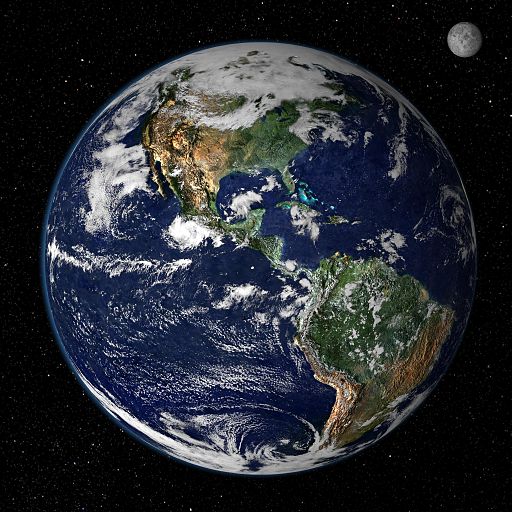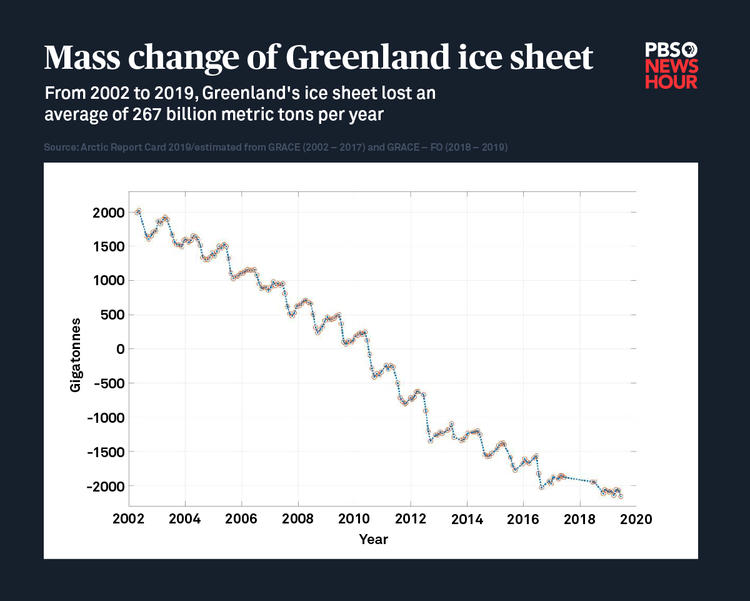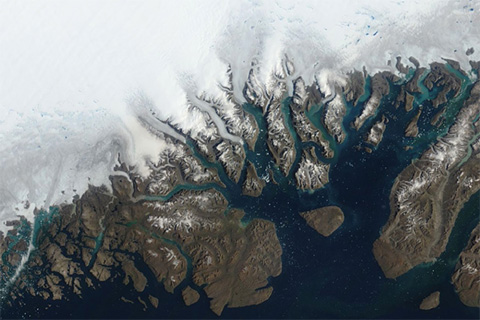Ann Arbor (Informed Comment) –
NOAA has issued its annual report on the Arctic. It is a big report, but there are some terrifying findings.
Because this point is not always made in the journalism, it is important to underline why these monstrous things are happening. It is because you are driving your gasoline-fueled automobile and heating your house with coal and voting for politicians like Donald Trump and Mitch McConnell. The wrecking of our beautiful earth is on us.

NASA/GSFC/Reto Stöckli, Nazmi El Saleous, and Marit Jentoft-Nilsen
1. “The Greenland Ice Sheet is losing nearly 267 billion metric tons of ice per year and currently contributing to global average sea-level rise at a rate of about 0.7 mm yr.” That means the ice sheet is radically shrinking, and the seas are rising.
As Emma Gatten at the Telegraph puts it, the ice is melting 7 times faster than in the 1990s, yielding a rate of sea level rise that could put 40 million people at risk of flooding.
Nsikan Akpan of PBS quotes Dartmouth’s Eric Osterberg;
“Two hundred sixty-seven billion tons of ice is really hard to put into context, but you could start by imagining a herd of elephants charging into the ocean from Greenland,” Osterberg said. “If you imagine that, we’re talking about 2,000 elephants charging into the ocean every second. That’s how much mass is going from Greenland into the ocean.”
As a journalist, let me just suggest you’d get more mileage from the imagery if you said it was like 7.2 million elephants charging into the ocean from Greenland every hour of the day, every day of the year.
2019 melt season on Greenland rivaled 2012’s record-melt year.
2. “Thawing permafrost throughout the Arctic could be releasing an estimated 300-600 million tons of net carbon per year to the atmosphere.”
The permafrost had been a carbon sink in the summer, but now it may be tipping over to releasing more carbon dioxide into the atmosphere in the winter than it takes in during the growing season. So it is a net producer of C02, alongside humankind, which is spewing out the stuff like 7.7 billion active volcanoes. We didn’t need the help, and this tipping point was supposed to be in the far future.
Bruce Johansen at the University of Nebraska Omaha explains:
- “In a study published in Nature Climate Change, scientists estimated that 1.7 billion metric tons of carbon were lost from Arctic permafrost regions during each winter from 2003 to 2017. Over the same span, an average of 1 billion metric tons of carbon were taken up by vegetation during summer growing seasons. This changes the region from being a net “sink” of carbon dioxide — where it is captured from the atmosphere and stored — into being a net source of emissions.”
3. “August mean sea surface temperatures in 2019 were 3° F. (1.7° C. ) warmer than the 1982-2010 August mean in the Beaufort and Chukchi Seas, the Laptev Sea, and Baffin Bay.”
Warm surface water means less ice. In fact, the result came too late for the report, but it turns out that October, 2019, saw the lowest extent of Arctic sea ice on record.
In general, 2019 will likely be the second hottest year on record over-all, rivaling the blistering year of 2016.
4. “Wildlife populations are showing signs of stress. For example, the breeding population of the ivory gull in the Canadian Arctic has declined by 70% since the 1980s.”
If you’re up there, apparently you can see the dead birds littering the beaches.
Christina Larson at AP reports,
- “Birds are migrating to the Arctic and not finding the food they need,” said Matthew Druckenmiller, a scientist at the University of Colorado Boulder’s National Snow and Ice Data Center and one of the NOAA report editors. “They are showing up with empty stomachs on the beaches. The indigenous communities are reporting seeing seabirds dead on beaches in numbers they haven’t seen before.” Arctic Canada’s breeding population of ivory gulls has declined 70% since the 1980s, the report found. This is likely due to loss of sea ice as well contamination in the food chain.
Waleed Abdalati, an environmental scientist at the University of Colorado -Boulder, one of Larson’s interviewees, compared the ivory gull to a canary in the mine.
5. “Loss of sea ice and changes in bottom water temperature caused Arctic fish species to shift to more northern waters between 2010 and 2018. Commercially valuable southern species are expanding their range north to take advantage of changing conditions.”
As Timothy Gardner and Yereth Rosen at Reuters point out, the Bering Sea is one of the United States’ largest fisheries.
I didn’t know this, but they say more than 40% of the yearly American fish and shellfish catch comes from the Bering Sea. If some of those species migrate north out of reach of the US trawlers, that will affect the American protein stock.
As a historian, I have taught courses on climate change and history, and one thing I can tell you, it is very unusual during the past million years for the Arctic to be hot.
——-
Bonus video:





 © 2025 All Rights Reserved
© 2025 All Rights Reserved